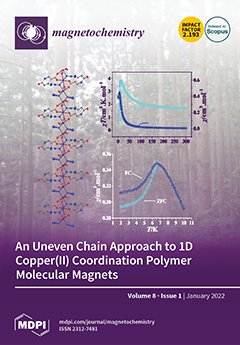In earlier work, we previously established a formalism that allows to express the exchange energy
J vs. fundamental molecular integrals without crystal field, for a fragment A–X–B, where A and B are 3
d1 ions and X is a closed-shell diamagnetic ligand.
[...] Read more.
In earlier work, we previously established a formalism that allows to express the exchange energy
J vs. fundamental molecular integrals without crystal field, for a fragment A–X–B, where A and B are 3
d1 ions and X is a closed-shell diamagnetic ligand. In this article, we recall this formalism and give a physical interpretation: we may rigorously predict the ferromagnetic (
J < 0) or antiferromagnetic
(J > 0) character of the isotropic (Heisenberg) spin-spin exchange coupling. We generalize our results to
ndm ions (3 ≤
n ≤ 5, 1 ≤
m ≤ 10). By introducing a crystal field we show that, starting from an isotropic (Heisenberg) exchange coupling when there is no crystal field, the appearance of a crystal field induces an anisotropy of exchange coupling, thus leading to a
z-
z (Ising-like) coupling or a
x-
y one. Finally, we discuss the effects of a weak crystal field magnitude (3
d ions) compared to a stronger (4
d ions) and even stronger one (5
d ions). In the last step, we are then able to write the corresponding Hamiltonian exchange as a spin-spin one.
Full article





